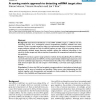Free Online Productivity Tools
i2Speak
i2Symbol
i2OCR
iTex2Img
iWeb2Print
iWeb2Shot
i2Type
iPdf2Split
iPdf2Merge
i2Bopomofo
i2Arabic
i2Style
i2Image
i2PDF
iLatex2Rtf
Sci2ools
ALMOB
2008
2008
A scoring matrix approach to detecting miRNA target sites
Background: Experimental identification of microRNA (miRNA) targets is a difficult and time consuming process. As a consequence several computational prediction methods have been devised in order to predict targets for follow up experimental validation. Current computational target prediction methods use only the miRNA sequence as input. With an increasing number of experimentally validated targets becoming available, utilising this additional information in the search for further targets may help to improve the specificity of computational methods for target site prediction. Results: We introduce a generic target prediction method, the Stacking Binding Matrix (SBM) that uses both information about the miRNA as well as experimentally validated target sequences in the search for candidate target sequences. We demonstrate the utility of our method by applying it to both animal and plant data sets and compare it with miRanda, a commonly used target prediction method. Conclusion: We show ...
Related Content
| Added | 08 Dec 2010 |
| Updated | 08 Dec 2010 |
| Type | Journal |
| Year | 2008 |
| Where | ALMOB |
| Authors | Simon Moxon, Vincent Moulton, Jan T. Kim |
Comments (0)

